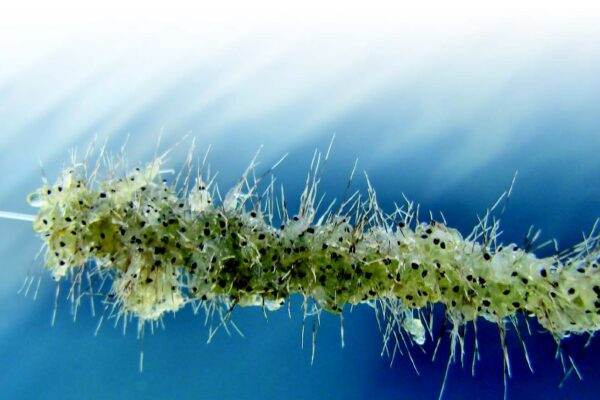Spiny & Fishhook Waterfleas

Spiny & Fishhook Waterfleas (Bythotrephes longimanus & Cercopagis pengoi)
The spiny waterflea and the fishhook waterflea are tiny freshwater crustaceans that threaten aquatic ecosystems and fishing. They are not true fleas, but predatory cladocerans that consume native plankton and collect in cotton-like masses on fishing lines and downrigger cables.
Species Description
Clumps of waterfleas look and feel like gelatin dotted with tiny black spots (eyes). Magnification is needed to see the transparent bodies, which range in length from 6-16 mm for the spiny waterflea and about 10 mm for the fishhook waterflea. The tail of the spiny waterflea is long and straight with several spikes or barbs, making up 70 percent of the total body length. It has a ball-shaped head with large eyes that are clearly separated from the body. The tail of the fishhook waterflea is highly angled at 90 degrees away from the body and has a unique loop or “hook” at the tip, taking up 80 percent of the total body length. The fishhook waterflea has a single, large, compound eye and its egg pouch is elongated and pointed.
Native & Introduced Ranges
Both species of waterflea are native to Europe and Asia. The spiny waterflea is found in Europe and northern Asia, and the fishhook waterflea is found in the Ponto-Caspian basin in southwest Asia. They were most likely brought to the Great Lakes in the ballast water of transoceanic ships, and were first discovered in Lake Huron in 1984. Since their introduction, waterfleas have rapidly spread throughout the Great Lakes, and to some inland lakes. In Pennsylvania, both species of waterflea are found in Lake Erie.
Biology & Spread
During the summer, when surface waters are warm, waterfleas produce new generations through parthenogenesis (no fertilization), which results in clones of the mother. Because males are not needed for parthenogenesis, they are rarely found when food is plentiful or when environmental conditions favor rapid population growth. When food becomes limited, or when temperatures cool in the fall, males are produced that mate with females. Eggs are released from the female’s brood pouch to sink to the bottom of the lake where they can survive the cold winter. Fishing, boating, and other recreational equipment can help transport waterfleas and their eggs to new areas, including inland waters.
Habitat
Both waterfleas can be found in freshwater to brackish lakes. They prefer open, deep, clear waters ranging in temperature from 46-86°F (8-30°C). While they prefer lakes, they can also be found in wetlands, estuaries, and marinas.
Impacts
Threat to Biodiversity
These tiny predators disrupt food webs by feeding primarily on small planktonic animals called zooplankton. Their high reproductive rate and ability to build large populations quickly, allows them to deplete the zooplankton population, which small juvenile fish and other aquatic organisms need for food.
Economic Costs
Waterfleas can be a significant nuisance to anglers and have negative impacts on the recreational fishing industry. They collect on fishing lines and accumulate in high numbers on the tips of fishing rods, making it difficult to reel in the lines. The commercial fishing industry can also be impacted as waterfleas collect on commercial fishing nets and downrigger cables.
Prevention & Control
The reproductive traits of waterfleas make them very difficult to control and almost impossible to eradicate. Resting eggs give them an advantage over management techniques by lying dormant and resisting unfavorable conditions, allowing them to hatch several years later. Strict ballast water regulations and preventing their spread to new bodies of water are the most realistic strategies in dealing with waterfleas and other invasive species.
Learn to identify spiny and fishhook waterfleas so new sightings can be reported. Always check for and remove any plants, mud, and debris from boats, trailers, clothing, fishing lines and equipment before leaving a water body. Drain all water from equipment, bilges, and live wells before transporting to new areas. Since bait buckets can carry microscopic organisms, never transport bait bucket water to another location. Clean all gear and equipment with either hot water (140°F/60°C), or salt water, OR let boats and equipment dry thoroughly for at least five days before entering a new water body.
References:
Keller, D. 2005. Spiny and Fishhook Water Fleas. Indiana Department of Natural Resources. Lui, K., Butler, M., Allen, M., de Silva, J., and Brownson, B. 2008. Field Guide to Aquatic Invasive Species: Identification, collection, and reporting of aquatic invasive species in Ontario waters. Ontario Ministry of National Resources.



